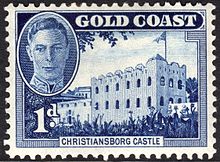Osu Castle
| Osu Castle | |
|---|---|
| Part of Danish Gold Coast | |
 Osu Castle | |
| Site history | |
| Built | 1661 |
| Garrison information | |
| Occupants | Denmark-Norway (1660) |
| Part of | Forts and Castles, Volta, Greater Accra, Central and Western Regions |
| Criteria | Cultural: (vi) |
| Inscription | 1979 (3rd Session) |

Osu Castle (also known as Fort Christiansborg or the Castle) is a castle located in Osu, Ghana, on the coast of the Gulf of Guinea in Africa.
A substantial
In 1902, Osu Castle became the
Because of its testimony to European colonial influence in West Africa and the
History

The area was first occupied in 1550 by the

Osu Castle was located close to two other forts.
In 1679 or 1680, the fort's
The
In 1850, the British bought all of Denmark's
In 2005, there was debate over whether Osu Castle should be replaced as the seat of government. President John Kufuor argued that his government should not sit at the castle due to its previous association with slavery and also because its facilities were inadequate. National Democratic Congress MPs, however, argued that the $50 m that a new presidential palace would cost would be better spent elsewhere.[11]
Features

Osu Castle is no longer the seat of government. The seat of government is now the
The present castle is made up of various extensions to the original and is thus in an unorthodox shape. It has many facilities for the use of employees, including a clinic, café, shopping centre and a post office. It also still accommodates a permanent garrison. The extensive gardens feature a wide variety of plants, both local and imported, and employ 30 people. They are used for the president's outdoor receptions and parties.[1] The Castle is closed to walk-in visitors.[12]
Controversies
In 2007, the opposition
The opposition
Gallery
-
Osu Castle, also known as Fort Christiansborg, is a castle located in Accra.
-
Osu Castle, also known as Fort Christiansborg, is a castle located in Accra.
-
Osu Castle, also known as Fort Christiansborg, is a castle located in Accra.
-
Christianborg Castle, Ghana
-
Christianborg Castle, Ghana
-
Christianborg Castle, Ghana
-
Osu Castle in Ghana
References
- ^ a b c d e f g h ghanacastle.gov.gh Archived 3 April 2007 at the Wayback Machine
- ^ "Forts and Castles, Volta, Greater Accra, Central and Western Regions". UNESCO World Heritage Convention. Retrieved 9 October 2022.
- ^ van Dantzig and Priddy, pp. 18–21.
- ^ worldstatesmen.org "Ghana" World Statesmen.org.]
- ^ a b van Dantzig and Priddy, p. 22.
- ^ van Dantzig and Priddy, p. 24.
- ^ van Dantzig and Priddy, p. 39.
- ^ van Dantzig and Priddy, p. 49.
- ^ "Ghana Museums & Monuments Board". www.ghanamuseums.org. Retrieved 22 October 2019.
- ^ "shoutghana.com". Retrieved 7 February 2007.
- ^ "Ghana in presidential palace row", BBC News, 15 December 2005.
- ^ "Ghana Museums & Monuments Board". www.ghanamuseums.org. Retrieved 19 October 2019.
Sources
- Albert van Dantzig; Barbara Priddy, A Short History of the Forts and Castles of Ghana (Accra: Liberty Press, 1971).









